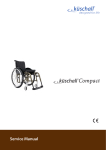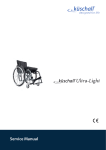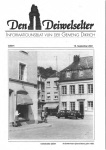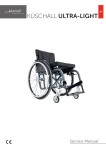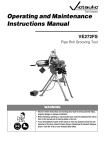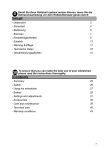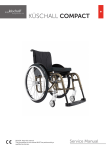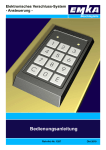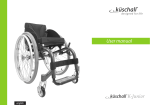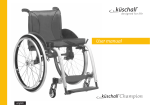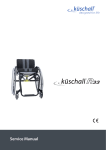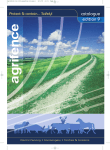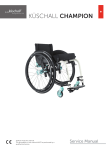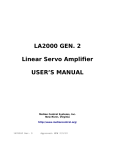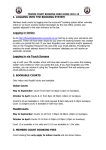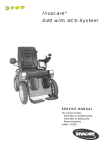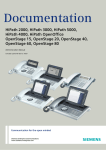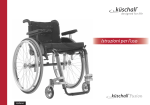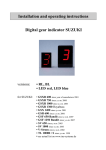Download Kuschall Kid User Manual
Transcript
Sie Ihren Rollstuhl optimal nutzen können, lesen Sie die D Damit Gebrauchsanleitung vor dem Rollstuhleinsatz genau durch. Inhalt - Uebersicht - Sicherheit - Bedienung - Bremsen - Einstellmöglichkeiten - Zubehör - Wartung & Pflege - Technische Daten - Gewährleistungspflichten 3 4 5 7 9 13 17 18 21 To ensure that you can make the best use of your wheelchair, GB please read the instructions thoroughly. Contents - Summary - Safety - Using the wheelchair - Brakes - Settings and adjustments - Accessories - Care and maintenance - Technical data - Warranty conditions 25 26 27 29 31 35 39 40 43 1 Summary In order to make these instructions easier to use, the drawing below illustrates the most important components. GB Compact Plus Backrest upholstery Tipper aid Wheelhub with floating axle Ultra-Light Neo Küschall Compact Contact Hemi Küschall Kid Quality policy Our primary mission is, through modern technology, to accelerate the rehabilitation process of customers with individual profiles and to enhance their mobility and independance. Increasing the quality of life does not just mean to fulfill our customer's expectations but to surpass them. To maintain the achievement of this goal, we aim our efforts on the constant improvement of the quality of both our wheelchairs and our customer-services. 25 Safety GB Please adhere closely to the following safety instructions: Weight limitations Maximum load: 120 kg (60 Kg for Kid Neo). Pneumatic air pressure / Brakes characteristics Sufficient air pressure should be kept in the tyres in order to maintain a good performance of the brakes Observe a weekly check of the tyre pressure! Types of tyres Lightweight tyre: Sculpture tyre: Lightwall-High pressure tyre Sportshall tyre (Collé): Air pressure 7 bar 7.5 bar 10 bar 10 bar Floating axles When operating the "quick Release" floating axles of the backwheels, make sure each time that the axles are well engaged (see "Use: rear wheels: assembly and removal"). Seat tubes Whenever you unfold the wheelchair, ensure that the seat tubes are fully engaged into the frame (see "Use: unfolding the wheelchair"). Leg supports After every adjustment, check that the leg supports are well engaged into the frame (see"Use:: unfolding the wheelchair"). Tilting The rear wheel position is adjustable. Please note that such wheel adjustments have an effect on equilibrium and/or the "stability" of the wheelchair! The right seat position depends on factors such as the body-weight, the type of handicap and the user's capabilities. Details on the standard adjustments of the seat position are given on the prescription form. If you wish to determine the tilting-point of your wheelchair, make sure somebody stands behind you, ready to prevent the wheelchair from tipping backwards. A more secure solution is to equip the wheelchair with an anti-tip device from our range of accessories (see "Accessories: Swing-away anti-tip device"). 26 Threaded joints Always tighten all screws and nuts firmly after each adjustment. Screws may come slightly loose with time, especially when the wheelchair is in constant use; we therefore advise you (or your Küschall/Invacare dealer) to control the tightness of the screws monthly. GB Life expectancy When the wheelchair is used on a daily basis, it is under constant pressure and is subject to natural wear. Under such conditions, and assuming the wheelchair is regularly serviced, the estimated life expectancy is 5 to 8 years for all Küschall wheelchairs. The more scarcely the wheelchair is used, the longer this expectancy will be. Using the wheelchair In order to prevent any accident, please follow these instructions carefully: Driving the wheelchair - Avoid driving on steep surfaces and give special care in presence of gravel or when the surface is either wet or uneven. - Drive at night only under secure light conditions (see and be seen) - Drive carefully over side obstacles, steps or door frames. - Give special care when driving up-hill (best is to have a companion standing at the back of the wheelchair). - Always adjust your speed to the situation and the environment. Transfers and loading of the wheelchair Make sure you have been trained by professional staff before undertaking such actions. If your legs cannot support your weight, a side transfer is the solution: move the wheelchair alongside the object in question and position it at a slight angle, so that the rear wheel and the footplate on the transfer side touch it. Apply both wheel locks. Remove the armrest on the transfer side. Move forward so that you sit on the front edge of the seat. Place one hand on the surface you are transfering to and the other on the frame or seat of the wheelchair. Then shift your centre of gravity towards the object of transfer and pull yourself over. Brakes The supplied brakes are foreseen as immobilisation brakes. Using them while in movement is not recommended. Should the brakes still be misused, küschall design and Invacare cannot be held responsible. General safety precautions and useful tips - When entering or leaving your wheelchair do not stand on the footplates. - Maintain proper balance at all times. - Do not attempt to pick up objects by reaching between your knees. - Do not attempt to reach objetcs by moving forward on the wheelchair. - Do not lean over the top of the backrest - Do not hang heavy loads or objects on the backrest. 27 GB Unfolding the wheelchair Tip the wheelchair slightly to one side so that the load is taken from one driving wheel. Then with your other hand push one of the seat tubes downwards - the wheelchair unfolds. Let the wheelchair go again so that it rests on all four wheels. Now press both seat tubes into the latches (pressure on both tubes is only necessary whilst the wheelchair is new; once the folding mechanism is running smoothly, pressure on one seat tube will be sufficient). Fitting the leg supports Introduce the plastic pegs of the leg support into the top opening of the frame as far as the stop, holding the leg support at a right angle to the side frame. Rotate the leg support forwards until it engages and is positioned parallel to the side frame. Repeat for the second leg support. The footrest can now be folded down. Folding the whleechair If you have a seat cushion, remove it. Fold up the footrest. Now hold the seat cover at the front and the back and pull it upwards. This unlatches the seat tubes and the wheelchair folds up. Removing the leg supports Pull the release lever back and swing out the leg support simultaneously to an angle of 90° to the side. The leg support can then be removed by pulling it upwards. Repeat the procedures for the second leg support. Footplate Palette repose pieds Rear wheels: Assembly and removal When necessary, you can reduce the bulkyness of your wheelchair even further by removing the backwheels. The "Quick Release" floating axles, considerably simplify this operation. Assembly Release the brakes. Hold the wheel around the hub, through the spokes with one hand. Press the axle knob with your thumb and slide the wheel into the axle plate socket until the stop. Release the button - the backwheel is installed. de roue AdapterPalier sleeve 28 CAUTION: Make sure that the axles are well engaged and that the axle knob is not pressed down. Check by pulling the wheels outwards. GB Removal Release the brakes. Hold the wheel around the hub, through the spokes with one hand. Press the axle knob with your thumb and slide the wheel out of the axle plate socket. Brakes On wheelchairs a basic distinction can be made between parking brakes and drum brakes. The parking brake operates by means of a lever directly onto the tyres and is therefore highly dependent on a correct tyre pressure. Always ensure that your tyres have the correct pressure (see " Safety: Tyre pressure"). As mentioned in the name "parking brakes", this braking system is designed as a safety brake and not as a stopping brake. The drum brake, on the other hand, is not dependent upon the tyre pressure and is therefore safer when travelling along. Furthermore, graduated brake application is possible. Warning: The wheelchair can only be safely braked at low speed by the companion and remains steerable. Sudden braking during travel may lead to the passenger being thrown forward from the wheelchair. Drum brakes Operation by the attendant only! Braking: Press the brake handle on the hand grip. To lock the brake in position, pull the brake lever until the safety lever locks. You can now release the brake lever, and the wheelchair will remain braked. Releasing: To release the locked brake: Press the brake lever and push the small safety lever on the underside of the brake lever, so that it unlatches. You can now release the brake lever; the brake is released. 29 Standard brakes GB Actioning the brakes: push the brake handle down as far as the stop. Releasing the brakes: pull the brake handle back into vertical position. Pull brakes The models with removable leg supports are, for safety reasons, only fitted with the pull brake so that if the leg supports swing back the brake cannot be released. Actioning the brakes: pull the brake lever backward as far as the stop. Releasing the brakes: push the brake lever forward. Performance brakes Actioning the brakes: push the brake lever as far as the stop. The gripper swings against the backwheel. Releasing the brakes: pull the brake lever back. the brake gripper swings away from the wheel. Active brakes Actioning the brakes: pull the brake handle to the front, reaching either between or beside your knees. Releasing the brakes: push the brake handle back under the seat cover, reaching either between or beside your knees. Stoplock brakes Actioning the brakes: Lift the red handle positioned on the rear wheel hub and swing it to 180° so that it is placed against the hub again. Releasing the brakes: Swing the handle back into closed position. 30 Settings and adjustments GB We advise you to call upon your Küschall / Invacare dealer for any change or adjustment made on your wheelchair. Every Küschall wheelchair is made-to-measure, according to the detail given on the prescription form. A comfortable and energy sparing drive can however depend on small adjustments which can only be carried out once the wheelchair user has tried out his wheelchair. In order to conduct these adjustments, this chapter will go through the various adjustement possibilities. If you don't feel confident about making the adjustments yourself, we advise you to turn to your dealer for help. Adjustment of the brakes To adjust the brakes, loosen the Allen screw situated on the clamp (Allen key 5mm) and move the brake to the desired position. Whenever there is a change to the rear wheel position the brakes must be reajusted. The distance between the brake gripper and the tyre should be 25 mm, when the brakes are loose. In the case of the Performance brakes and the Active brakes, the brake gripper should penetrate no more than 4mm into the tyre, in the activated position. CAUTION: Make sure that the air pressure of your tyres is convenient (see "Safety: Tyre pressure").Tighten all screws firmly! 25 mm mm 15 Footrest height adjustment To adjust the height of the footrest, slacken the hexagon screws above the footrest using the 8mm open-ended spanner whilst steadying the 3mm hexagon head socket screw. Slide the foot section telescope to the desired height and insert the screws in the nearest holes. CAUTION : Ensure that the screws are securely tightened. Footsection tube telescope telescopique 31 GB Bottom tube adjustment with the Clamping System In order to adjust the height of the footrest slacken the hexagon head socket screw with the 5mm Allen key. Adjust the bottom tube length by smoothly sliding it along the frame tube and retighten the screw. Clamping Bride de serrage piece If necessary, use a conical object to expand the clamping piece so as to avoid damaging the paintwork on the surface of the frame tube. Height adjustment of the backrest tubes If you have a clothes guard fitted, slacken the screw on the rear frame tube (1). Remove the hexagon socket screw below the frame tube (2). If your model is fitted with a horizontal adaptor plate, this must also be removed (3 + 4).Slide the backrest tube to the desired position and re-tighten all screws. Adjusting the backwheel Vertical adjustment The adjustment of the backwheel has an effect on the floor to seat height and the seat angle and thus also on the stability of the chair: a) If the wheel axle is fitted at the top of the rear frame, the wheelchair will be less stable. b) If the wheel axle is fitted at the bottom of the rear frame, the wheelchair will be more stable. CAUTION : Adaptor sleeve palier de roue arrière Adaptor sleeve Adaptor plate Plaque porte Adaptor roue plate If the seat angle is changed the front wheel bearing block must be adjusted (see " Front wheel adjustment"). - Method for the standard vertical adaptor plate: Slacken the adaptor sleeve on the adaptor plate (22 mm open-ended spanner, steadying with 22mm open-ended spanner). Insert the adaptor sleeve in the desired hole of the adaptor plate and re-tighten. - Method for the horizontal adaptor plate: Slacken the adaptor plate (10mm open-ended spanner, steadying with 4mm Allen key). Fit the plate to the desired height and re-tighten. 32 - Method for the mini-adaptor plate: Slacken the mini-adaptor plate (10mm open-ended spanner, steadying with 4mm Allen key). Fit the plate to the desired height and re-tighten. GB Horizontal adjustment This adjustment influences the wheelchair's ability to tip: The further you place the rear wheel to the front of the wheelchair, the less stable the wheelchair will become. - Method for the vertical adaptor plate: Slacken the adaptor plate (10mm open-ended spanner, steadying with 4mm Allen key). Fit the plate to the desired position and re-tighten. - Method for the horizontal adaptor plate: Slacken the adaptor sleeve on the adaptor plate (22 mm open-ended spanner, steadying with 22mm open-ended spanner). Insert the adaptor sleeve in the desired hole of the adaptor plate and re-tighten. - Method for the mini-adaptor plate: The mini adaptor plate is used as a rear wheel extension when positioned backwards. Slacken the adaptor plate (10mm open-ended spanner, 4mm Allen key). Fit the plate to the desired position, either facing to the front or facing to the back of the wheelchair and re-tighten. Front wheel adjustment Height adjustment If your wheelchair model is equipped with a 5" or 8" front wheel fork, you can position the front wheel in one of the other axle seats available on the fork. Slacken the front wheel axle (13mm open-ended spanner, steadying with 13mm open-ended spanner) and place the castor to the desired height. ULTRA-LIGHT NEO The clamping lug can be fitted in two ways: - Pointing upwards=low front floor to seat height - Pointing downwards = high front floor to seat height (standard). Adjustment Slacken the threaded joint of the bearing Tête block de fourche (5mm Allen key). The two other clampingorientée vers le haut piece screws must also be slackened. By fitting at a 180° you will achieve the new front floor to seat height. When fitting the clamping pieces, ensure (before tightening the threaded joint) that the clamping pieces are at a right angle to the ground. Tête de fourche orientée vers le haut Tête de fourche orientée vers le ba Tête de fourche orientée vers le bas 33 GB Perpendicular adjustment of the castor bearing blocks To achieve an optimum performance, the bearing blocks must always be aligned vertically to the ground. Some Adjustments result in a change of the seat angle. the vertical position of the bearing blocks should then be adjusted. Method Slacken the two screws on the bearing block (10mm open-ended spanner, steadying with 5mm Allen key). Rotate the hexagonal/octogonal cam to adjust the bearing block vertically and re-tighten. CAUTION: Ensure that the octogonal cam adjustments on both sides of the wheelchair are identical (i.e. when the adjustments are the same, viewed from the fitting side, on one side the stamp marking on the octogonal cam is visible and on the opposite side it is not). (not valid for the hexagonal cam) angle d'inclinaison important Large seat angle angle d'inclinaison rédu Small seat angle Excentrique à 8 Octogonal pans cam Octogonal Excentrique cam Fourche Fork à 8 pans ULTRA-LIGHT NEO with titanium or Carbon front frame Since the bearing blocks are fixed, no adjustment is possible. Therefore, ensure that the seat angle of the wheelchair is always 4.2 +/- 1.5cm (seat angle = seat height at front - seat height at back). 34 Accessories Backrest angle adjustment Slide the bottom of the backrest upwards on the backrest tube - 2 hexagon socket screws will appear. Unscrew the bottom one completely (5mm Allen key). The backrest angle can be set in one of 4 positions: 0°, 3°, 8° and 12°. Select the corresponding hole, replace the screw and tighten again. CAUTION: The position of the screws must be identical on both sides. If the backrest is set backwards, the wheelchair is less stable. ! GB Point Hinge Fulcrum d'articulation Angle position 12° Position de réglage for 3° 3° and Position Angledeposition réglage 0° + 8° for 0° and 8° Upholstered Velcro-adjustable back Thanks to this Velcro system, you can decide on the firmness of the backrest and adjust the comfort of the wheelchair according to your needs: remove the padded upholstery, loosen the Velcro bands at the back of the backrest by simply pulling them apart. You can then adjust them in the new desired position, to suit your back. Folding hand grips At the top of the backrest tube, just before the bend on the hand grip, there is a metal sleeve. To collapse the hand grip slide this sleeve upwards. If you wish Bague to replace the sliding hand grip in the vertical posi- Metal Sleve tion, lift the grip and slide the sleeve downwards. CAUTION : Poignée Hand grip This folding hand grip is not designed to overcome obstacles. 35 Height-adjustable push handles, mounted back GB Thanks to its height adjustability, this option enables your companion to push the wheelchair comfortably. Because the push handles are set backwards, the user's shoulders will benefit from more freedom of movement. This is important for the mobility and independance of the user. Height adjustment Loosen the locking handle, adjust the push handles to the desired height and tighten the locking handle firmly. Swivel and height adjustable armrests Swivel Slightly raise the back of the armrest and swivel it to the required position or, if necessary, pull upwards to remove it. Height adjustment Remove the armrest (pull it out of the retaining sleeve). Slacken the screw on the underside of the armrest tube (4mm Allen key) and move the bolts inside the tube to the desired height. Fit and retighten the screws in the next available hole. Vis six pans Swing-back and removable siderests Swing-back: Press the side release buton, and swing back the side rest. To bring it back into locked position, swing the side rest forwards until it engages. Removal: Press the release button. Swing the armrest backwards and remove it. To replace, insert into back socket, swing the armrest forwards until it engages. Height adjustable, swing-back and removable siderests Height adjustment: Pull the release lever. Move the armrest to the desired position. Press the release lever and slightly raise the upholstery until it engages. Swing-back: Press the side release buton, and swing back the side rest. To bring it back into locked position, swing the side rest forwards until it engages. Removal: Press the release button. Swing the armrest back and remove it. To replace, insert into back socket, swing forwards until it engages. Make sure that the armrest is locked into position. 36 Clothes guard / Fixed mudguard The clothes guard is fixed to a supporter plate. You can adjust it as follows: loosen the 2 screws (spanner 8mm or 10mm and Allen key 3mm). Level the clothes guard with the backwheel and position it in front of the next available hole. Tighten screws firmly. CAUTION: clothes Kleiderguard schutz GB Do not use the clothes guards as a support while transfering (danger of injury) Removable mudguard To remove, pull the tyre covers upwards. To Adjust, slighlty loosen the 2 screws binding the clip to the tyre cover. Shift the tyre cover until it covers the tyre in an optimal way. Tighten again. Transit wheels This option is necessary when the wheelchair becomes too wide for the circumstances (for example when faced with narrow doors and corridors). When unused, the transit wheels are situated several cm away from the ground in order to avoid disturbance. Loosen the spring clip and slide the transit wheel down to max. 2 cm from the ground. Slide the transit wheel further until the snap head engages into the next available hole. Before activating the transit wheels, make sure that the snap heads are well engaged! Place the wheelchair near a ramp or support, on a horizontal surface. Hold yourself to the ramp or support and lift the wheelchair slightly until the opposite backwheel lifts from the ground. Remove the backwheel (see: Using the wheelchair: "rear wheel assembly and removal"). Set the wheelchair back onto the ground - it now rests on one transit wheel. Repeat this operation on the other side - you can now drive on the transit wheels, taking support on both sides of the alley to move forward. CAUTION: Please remember that the brakes have no effect when using the transit wheels To change back to the normal 24" backwheels, reverse this operation. Tipper aid On the standard versions of the Compact Plus and ContactHemi Plus, the tipper aid is integrated in the rear frame. 37 GB With the design frame and on the Ultra-Light Neo, you can adjust the position of the tipper aid. Make sure not to adjust this position above the outer diamter of the rear wheel (can be dangerous when driving over a step) Swing-away anti-tip device This option stops the wheelchair from tiping backwards. To inactivate the anti-tip, press it downwards and swing it sideways inside the frame. CAUTION: In order to avoid a fall, the anti-tip should imperatively be swung-away whilst driving over a step or pavement. Cane holder Place the walking sticks into the holder and secure at the top to the hand grip shaft with the Velcro fastener. Lateral supports Swing-away and adjustable Passiv lights Fix the passiv lights on the backrest upholstery. Minimum height from the ground is 900mm. Maximum distance from the the side of the wheelchair is 400 mm. Use both red reflectors on the backrest and fix the yellow ones on the rear wheel spokes. Tool-kit / Air-pump The tool kit includes 2 Allen keys, 3mm and 4mm and 1 open-ended spanners, 8mm and 10mm. With this kit, most of the adjustments can be carried out. The air-pump is delivered with a valve adaptor. Depending on the size of the valve on your tires, this adaptor should be fitted on before Security belt Recommended when using drum brakes. 38 Care and maintenance In order to guarantee a good performance of your equipment, we advise you to carry out a carefull and regular check to your wheelchair. Do not use abrasive or heigh pressure cleaners on the wheelchair. Best is to wash it using a damp cloth or a bicycle spray. Dry your wheelchair thoroughly after a shower or a drive under the rain. Axles are especially important and should not be left wet. Spread a little bicycle oil on a cloth and wipe the axle beads, the knob at the end of the axles and the axles themselves. CAUTION: Sand and sea water damage the ball bearings! CAUTION: The screws may loosen a little with time. Therefore, remember to check the tightness of all screws from time to time. After slackening and tightening the counternuts several times, renew them to ensure their full performance. GB Tyre repair / change Dismantle Before repairing a damaged tyre, remove the wheel from the wheelchair (see " Using the wheelchair: rear wheel assembly and removal"). Press the valve until all remains of air are released. Lift one tyre side wall (both if you are changing the tyre) from the rim, using a bicycle tyre tool. Do not use a sharp or pointy tool. Then remove the air tube from the tyre. Mend the air tube using a bicycle repair kit or replace it altogether. Assembly Press the interface of the tyre over the rim side. Slightly fill the air tube with air until it reaches its normal round shape. Slide the valve through the appropriate hole and insert the air tube inside the tyre. Once the tube is well inside the tyre without pleats, press the outer side of the tyre over the rim, starting at the opposite side of the valve and pressing along the rim until you reach the valve again. Procede the same way on the other side. Check that the air tube is at no time trapped between the tyre and the rim and pum-up the tyre to the appropriate pressure (see "Safety: Tyre pressure). 39 Technical data GB Ultra-Light Neo Legend: SB Seat width SH v Seat height front 50 SH h Seat height back 45 SW Seat angle ST Seat depth RH Back height GB Total width GL Total length Wheelchair weight: Maximum user weight: 120kg Standard (cm) 33/36/39/42/45/48 5 40 37.5 SB+20 86-92 from 11.9kg Options(cm) 39.7-55 34-50.5 variable 30-50 31.5-48 (every 1.5) Küschall Compact Legend: SB Seat width SH v Seat height front 50 SH h Seat height back 46,5 SW Seat angle ST Seat depth RH Back height GB Total width GL Total length Wheelchair weight: Maximum user weight: 120kg 40 Standard (cm) 33/36/39/42/45/48 3,5 40 42 SB+20 approx. 92-98 from 13.3kg Options (cm) 43-55 34-50.5 variable 30-50 31.5-48 (every 1,5) Compact Plus Legend: SB Seat width SH v Seat height front 50 SH h Seat height back 46 SW Seat angle ST Seat depth RH Back height GB Total width GL Total length Wheelchair weight: Maximum user weight: 120kg GB Standard (cm) 33/36/39/42/45/48 Options (cm) 43-55 34-50.5 variable 30-50 31.5-48 (every 1,5) 4 40 37.5 SB+20 approx. 92-98 from 12.4kg Contact-Hemi Plus Legend: Options (cm) SB Seat width SH v Seat height front 40.5 SH h Seat height back 38.5 SW Seat angle ST Seat depth RH Back height GB Total width GL Total length Wheelchair weight Standard (cm) 33/36/39/42/45/48 2 40 37.5 SB+20 approx.91-95 from 12.4kg 34-47.5 34.5-47 variable 30-50 31.5-48 (every 1,5) 41 GB Kid Neo Legend: SB Seat width SH v Seat height front 50 SH h Seat height back 46 SW Seat angle ST Seat depth RH Back height GB Total width GL Total length Wheelchair weight Maximum user weight 60kg 42 Standard (cm) 27/30/33/36 4 33 37.5 SB+20 approx. 85-89 from 11.9kg Options(cm) 43-53.8 38-50.5 variable 30-38 31.5-48 (every 1.5) Warranty terms and conditions Standard terms This is to certify that your küschall design wheelchair is warranted by Invacare, for an unlimited period of time for the frame and crossbars and 12 months for all other parts. This warranty is subject to the following conditions: 1. Only Küschall design wheelchairs purchased at full price are warranted against defective workmanship and materials. 2. If a defect or fault is discovered the Invacare dealer from whom the appliance was purchased should be notified immediately. 3. The manufacturer will not accept responsability for damage caused by misuse or the non-observance of the instructions set out in the user manual. 4. During the period of the warranty, any parts that have become defective due to faulty workmanship or materials, will be renewed or repaired free of charge by the Invacare dealer. 5. The warranty will be forfeited should any unauthorised alteration be made to the equipment. 6. The purchaser's statutory rights under the Consumer Protection Act are not affected. GB Limitation of liability This warranty does not extend to the consequential costs resulting from fault clearance, in particular freight and travel costs, loss of earnings, expenses, etc. küschall design ag shall not be liable for: - natural wear and tear - unappropriate or incorrect use - defective assembly or setting-up by the purchaser or third parties - defective or neglectful treatment - use of unsuitable spares. 43




















